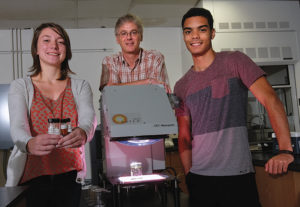
Charlie Sharpless (center) mentors July Laszakovits ’16, who studies degradation of pharmaceutical compounds in streams, and Orlando Stewart Jr. ’15, who studies how sunlight breaks down oil from a 2010 spill in the Gulf of Mexico.
Photo by Norm Shafer
Who: Charlie Sharpless, associate professor of chemistry
At UMW since: 2004
Academic specialties: environmental photochemistry; mentoring students in research projects
What is environmental photochemistry? It’s the chemistry that happens when sunlight is absorbed by compounds at the earth’s surface. These reactions happen in air and water, but since I’m a water chemist, I’m interested in what’s going on in lakes, rivers, and coastal marine systems.
What my students and I focus on is the way sunlight alters the oxygen chemistry in water and the effect that can have on contaminants. Normally oxygen isn’t very reactive but some of the natural organic matter – the brown stuff in water left over from plant and algae degradation – will transfer energy from the sunlight to the oxygen, and all of a sudden you get new kinds of oxygen chemistry that weren’t there before.
Can you give an example? One of the projects we’re working on is how photochemistry affects the fate of pharmaceutical compounds that make their way out of wastewater treatment plants into rivers. It’s funded through the National Science Foundation and involves collaboration with environmental engineers and earth scientists at the University of Connecticut and Ohio State.
What pharmaceuticals are you studying? There’s a list of about 15 we plan to monitor in our test sites. The pharmaceuticals that initially concerned the environmental chemistry community are ones that could have endocrine-disrupting steroidal effects in wildlife. Every once in a while studies appear in the news about hermaphroditic frogs or fish with abnormal sexual development, and there’s concern that these effects are linked to steroidal pharmaceuticals or even pesticides in the water. But nonsteroidal anti-inflammatory drugs, like ibuprofen, can have toxic effects on wildlife as well.
Is your sample site in the Rappahannock River? No. The Rappahannock thankfully has very little chemical contamination.
We have two sites in Connecticut and one in Ohio. The main one in Connecticut involves a wastewater plant that serves a retirement community of about 5,000 with associated medical facilities. The plant discharges into a small river. Every morning when folks go to the bathroom there’s a big flush. Around early afternoon if you’re measuring pharmaceutical compounds in the wastewater, you can see the pulse in the river of unmetabolized drugs excreted by people. Our colleagues at UConn are doing the analysis for pharmaceuticals.
Do your students go to Connecticut for this work? We mainly replicate the photochemistry in our lab here at UMW, but we will go to Connecticut to do some fieldwork later this year. Ideally, we’ll have a string of sunny days with no rainfall, and we should be able to judge the effects of sunlight by analyzing samples at different points downstream of the plant.
You also collaborate with scientists at Woods Hole Oceanographic Institution. How did that come about? In 2006, my wife and I decided to spend the summer at her family home in Falmouth, Massachusetts, which is near Woods Hole. I reached out to some scientists via email, and as serendipity would have it, one of them, Chris Reddy, actually had an environmental photochemistry problem. His team had been monitoring an oil spill on a Cape Cod beach, focusing on polycyclic aromatic hydrocarbons. These are components of oil, and they are environmentally persistent because they’re not water-soluble or very biodegradable. The PAHs on this beach were going away, faster above the tide level than below. Our hypothesis, which we published good evidence for, was that they were going away because of photochemistry. The rates were slower below the tide line because those rocks spent some of their day underwater and didn’t see as much sunlight as the ones above water. Recently, the Woods Hole folks and I have teamed up again to collaborate on another National Science Foundation project to figure out what role photochemistry played in degrading oil from the 2010 Deepwater Horizon disaster. Next September, we’ll go down to the Gulf of Mexico on a research cruise to collect some more samples, and this will involve a UMW student. I’m very excited.
